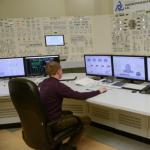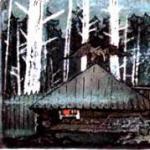Staged photography. Five tips for those who want to take good “sudden” photographs Staged photography
Needless to say, a wedding is one of the most memorable and exciting events in the life of every person. And it is quite natural that every beloved couple wants to preserve the memories of this day in bright and festive photographs, which could subsequently be viewed many times in moments of joy and misfortune. Wedding photography appeared as a genre at the dawn of photography in the mid-19th century. Despite the fact that at that time photographs were taken on glass or metal plates, and the photography process itself was very far from ideal, newlyweds lined up to see the photographer to be photographed in their wedding dresses.
Today, wedding photography is considered a special art form in photography. Wedding photography combines such genres as artistic portraiture, reportage, product and interior photography. For a photographer, photographing a wedding is a big responsibility, because wedding photographs will have to remind the couple for decades to come about their feelings and happy moments on this special day.
Wedding photography: staged and reportage style
Nowadays, it is customary that beloved couples turn to the services of an experienced, professional photographer who is capable of performing wedding photography at the highest level. The demand for such services is constantly increasing, despite the fact that the genre itself wedding photography remains quite conservative.
There are two main styles in wedding photography:
— Classic staged photo
The first style includes classic, staged photography, which appeared in the 19th century. Then photographers took exclusively staged photographs, which were designed to convey the newlyweds’ feelings for each other. Such photographs were preserved as souvenirs for future generations. The staged style is still widely used in wedding photography today. In many ways, this is where the photographer’s talent is revealed as a kind of director and plot director, whose main goal is to reveal the true feelings and emotions of young people.
Staged photography involves capturing individual moments of the wedding day, mainly in the form of narrative and portrait photographs. Not only the bride and groom, but also parents, friends or relatives may be present in the frame, that is, staged group photographs are taken.
Staged photos, in particular, are taken during the ceremony at the Wedding Palace and the newlyweds’ walk. Festive shots with the cutting of a cake or the lighting of a symbolic “family hearth” are also traditional for the production style. Staged photographs allow you to convey the beauty of wedding dresses, flowers and hairstyles, as well as the feelings of the married couple. But to get bright and beautiful staged photographs, the photographer has to come up with some original and interesting plot, and not use simple templates.
— Reporting style
The reportage style in wedding photography arose much later, when photographers had access to enough compact cameras with flashes and interchangeable optics. This style is considered one of the most difficult types of shooting. In this case, the photographer does not interfere in any way with the special event, without indicating to the guests or newlyweds when they need to take a certain pose, look into the camera lens or smile. His task is to be invisibly present at the wedding and notice the most interesting and exciting moments of the celebration, capturing them in photographs. The difficulty of such shooting lies precisely in the photographer’s ability to see unique moments and have time to capture them in the frame, because most of such moments at a wedding cannot be repeated.
The reportage style is the complete opposite of the classical one: here the photographer needs to see an interesting shot in a constantly changing environment and work, as they say, “from the first take.” But it is shooting a wedding in a reportage style that allows the photographer to truly reveal his talent, show his individuality and his own vision of the events taking place around him. It is not without reason that many famous wedding photographers have received wide recognition thanks to their reportage photographs. Often, reportage shots from a wedding look much more interesting than staged ones, since they use unusual angles and shooting angles, and convey dynamic moments with the newlyweds dancing, sneaking a kiss, breaking glasses and throwing a wedding bouquet.
For reportage photography, the possibility of modern digital cameras shoot several frames per second, which allows you to capture truly unique moments in your photos. The peculiarity of reportage photography is that in each individual case, be it a wedding ceremony in the registry office or a festive banquet, the shooting is carried out in completely different conditions. As a result, the photographer needs to stock up on a whole set of interchangeable lenses and apply different approaches to building exposure and shooting parameters.
In addition to staged and reportage photography, there are also special types of photography in wedding photography. For example, a pre-wedding photo shoot in the style of Lovestory (“Love Story”). This is a preliminary shooting, during which the photographer, together with the newlyweds, can choose the most beautiful and advantageous places in the city or in nature, as well as determine the most successful angles and scenes for staged photographs. Since a wedding day comes only once in a lifetime and it will be impossible to repeat it (at least in this composition of the bridegrooms and guests), such preliminary photography and planning turn out to be very useful.
Currently, most wedding photographers work in both staged and reportage photography, trying to successfully combine both genres. Although each of these styles requires a special approach and special skills from the photographer. But long wedding celebrations with a ceremony in the registry office, a walk and a festive banquet allow you to take both staged and reportage shots.
Black and white wedding photographs look very good, so quite often newlyweds order just such shots from a photographer. Also, wedding photos can be digitally processed, for example, to change or blur the background, or to make them look antique. Moreover, today very popular enjoy colorful wedding collages.

Outdoor and indoor wedding photography
When performing wedding photography, a photographer should always be guided by several important points. Firstly, wedding photographs should convey warm feelings and positive emotions of the newlyweds. A sincere smile, a loving or intimate look, a pose - all this acquires great significance in wedding photos. Such emotions cannot be created using software already in the process of digital processing of photographic images. Processing only helps to enhance or emphasize these points. That is why a wedding photographer is required to be able to feel and convey sincere emotions in photographs.
Secondly, the responsibilities of a wedding photographer include searching for the most interesting and striking moments. This is very difficult and requires a lot of experience, since he simply cannot be physically present at all events. In any case, it is advisable for the photographer to stay close to the newlyweds, since all the most important things will happen around them.
The entire ceremonial part usually takes place in the Wedding Palace, where the shooting and actions of the photographer are strictly regulated. At this stage, when shooting in the halls and premises of the registry office, the photographer is simply required to technically correctly record the ceremony in conditions where the spread of illumination in different parts of the hall can vary greatly - there is usually more than enough light under the chandeliers, but sometimes there is sorely not enough light at the edges.
You can achieve a high-quality result only if you use all available lighting wisely. In some cases, a flash can be a good assistant for a photographer. At the Wedding Palace, in addition to taking pictures of the ceremony, you can also take several staged photographs against the backdrop of the interiors.
When photographing newlyweds while walking, the photographer is more free in his actions and plans. Both staged and reportage photographs are welcome here. Outdoors, you can use a longer focal length lens to create three-dimensional shots that make your main subject stand out from the surrounding area. In particular, a wedding photographer’s arsenal should include 85-135 mm lenses with an aperture ratio of 1.4-2.8.
The most interesting and striking shots can be taken during a walk, when the photographer can try on the role of a director and work on a variety of subjects. Footage from a walk, as a rule, turns out to be very lively and cheerful. When shooting walking, you should also not forget about the flash, which in cloudy weather will help smooth out the lack of natural light. The main thing is not to miss a single moment, since every next moment can be important.
When shooting outdoors, a photographer must have a variety of photographic equipment and a whole set of lenses with him. You never know what will happen with the weather or lighting. Sunny weather can completely unexpectedly give way to heavy rain and the photo shoot will have to be urgently moved indoors or under a roof. That's why experienced wedding photographers always take two cameras with them to shoots - one with wide-angle optics, the other with a telephoto zoom lens. It is advisable to use high-aperture and sharp optics.

Posing
One of the most important aspects of wedding photography is posing. Here you need to remember that wedding photographs are the fruit of the joint work of the photographer and the newlyweds. The choice of certain poses should be determined not only by the photographer’s intention, but also based on individual characteristics couples, as well as their personal wishes. Before shooting, the wedding photographer should try to relax the couple by talking with the bride and groom. It is necessary to help the newlyweds relax so that on this holiday they can calmly throw away all their worries and give free rein to their feelings. The presence of a photographer at wedding events should not distract the couple in love.
Unnaturally freezing in one position is a fairly common mistake for the bride and groom when posing in wedding photographs. You probably won't want to look at these pictures. Much more interesting are the shots in which the bride and groom smile and laugh a lot, flirt with each other and literally glow with happiness. The classic pose for wedding photography is when the newlyweds are close to each other, holding hands, and their gaze is directed directly into the camera lens. In this case, the background must correspond to the stylistic decision of the photograph.
When photographing the newlyweds while sitting, the groom can hug his beloved around the waist and hold her hand with his other hand. The bride can put her free hand on her dress or on her knees. It is important to pay attention to the position of your hands - under no circumstances should they simply be lowered limply. A beautiful and gentle photo is obtained when shooting in a “face to face” pose. This position is ideal for couples where the bride and groom are approximately the same height.
Photos are interesting when the bride and groom stand at a distance of a meter from each other, leaning over to kiss. All you need is the right background, with the help of which you could ideally play up the symmetry of the composition. The collection of wedding photos must also include a photograph in which the bride looks into the camera lens, and the groom looks at her, or vice versa. This pose can be called “one look.” When photographing hugs, you need to make sure that the bride simply rests her head or leans lightly on the groom's shoulder, while he stands straight, looking either at the camera or at the bride. When photographing the newlyweds in various poses, do not forget about the smile.
Gone are the days when wedding photographers in the registry office photographed newlyweds literally as if on an assembly line, with standard poses and angles. The output was the same type of photographs, the same as those of other couples. Today, the tasks of a wedding photographer include the need to use all the equipment, experience and knowledge available in his arsenal to ensure that the finished photographs literally radiate love, happiness and romantic feelings. Naturally, such work requires from the photographer not only relevant knowledge, but also the ability to be a psychologist, to subtly feel people’s experiences and the atmosphere of the holiday.
Photography is one of the few types of art in which the result (i.e. photo) can be obtained through both initial preparation, thinking, and completely spontaneously. Not every sculptor picks up a piece of clay without at least roughly knowing what he wants to sculpt. Just as an artist is unlikely to initially simply move a brush across the canvas until he gets something that looks like a painting. But in photography, both ways of creating works are possible.
There are two main types of photographer's work: staged photos and random, spontaneous shots.
Let's look at them in order.
What is staging?
In short, this is the implementation of a certain plan, scenario.

In photography, this is done using the shooting point, angle, photographic equipment, optics, light, actors, filters and more. Staged photography or, as it is also called, artistic photography, implies an idea in design. This is the basis of any staged photo. It will differ from all the others in that it does not imply an objective reflection of reality, but rather captures pictures specially selected or hand-made for photography in order to display a certain artistic idea.

Look through albums at home. Wedding photos, photos of other celebrations, staged photos of boys in musketeer hats and girls in lady costumes from their school years. Any photos where the model is posing in any way. These are all staged photos. In ordinary life, this genre is used for photographing special, memorable events and carries certain information about the event, characters and, as a rule, many of these photographs are labeled “memory.”

But there are also professional productions. They are dealt with by professional photographers in their studios, where anyone can order a special series of photographs with a specific plot. Or the photographer is engaged in this type of shooting for himself, in order to improve his own skills, obtain real works of art that are worthy of even serious exhibitions, and their cost is calculated in considerable amounts.

This type of work requires various technical components. Camera, lighting, final processing of the image, elements of purposeful materialization - objects, actors, makeup, natural elements, and, directly, the artistic idea. This is a kind of result of a set of images and technical ideas that require quite serious skills and knowledge in working with photography, and, of course, the artistic eye and imagination of the photographer, which, however, does not deprive amateur photographers of the opportunity to try their hand at staged photography. photography. This is available to everyone, because... The main condition for them is the presence of imagination and imaginative thinking.
Now let's move on to the second type of photographic work.
What is a spontaneous photo?
A spontaneous, random photo is interesting in its own way and much more filled with life. There are also no restrictions on the degree of professionalism, the presence of expensive optics or props, and, again, there is required condition the presence of imagination and artistic vision on the part of the author.

What is the difference then, you ask?
Firstly, in the absence of a choreographed, artificial plot and planned pictures for shooting. Secondly, such photographs could not be more subtle and accurately reflect the characteristics of a person’s character, his emotional and mental state. We can say that these are the most true photos. And that's why.

This genre involves a “hunt” for real pictures of everyday life, the living emotions of people who are unaware that they are being filmed, people who are carried away by experiences or some kind of action. For family album You can take such pictures without leaving your home, capturing moments in the real lives of your loved ones, pets, and trying to catch a frame in which the character has not yet realized that he is being photographed and is enthusiastically busy with something of his own. For more serious work in the same way, by going out into the street, in any weather, just according to your mood and without any specific thought, walking around the city, you can notice many interesting pictures and entertaining situations.

The keen eye of a born photographer will immediately snatch from the bustling crowd, even in bad weather, one face shining with happiness, a person completely immersed in himself, or ready to cry. Usually, passers-by rarely notice this - everyone is in a hurry about their business. Here is a touching moment - a three-year-old toddler, who has no idea that he is being watched, hands his candy to the fawning mongrel. Or a girl in thin stiletto heels, indignant at the annoying drops of the beginning rain, runs to a dry place to shelter from the weather. Not noticing anyone around, he makes a very funny cute face. These are the most simple examples of what spontaneous shots can be. But with the acquisition of experience and skills in classical photography, you can also achieve amazing results in this genre.
In its specificity, professional staged photography is very close to the work of an artist and requires no less talent. There should be nothing superfluous in the frame. The main feature of staged photography is the thoughtfulness of the little things that get into the frame. The role is played by the pose of the model, the background, as well as the plot. Unlike standard photography, you do not get a moment captured by chance, but the result of the joint work of the photographer and the person who gets into the frame. Professional staged photography in Belgorod is carried out by a photographer with extensive experience who has a creative approach to solving the task. But you need to understand that preparing for filming will take a lot of time. Haste can ruin the result; it is important to pay attention to every detail. The shot itself takes a fraction of a second; most of the time is spent on preparation, which is the emphasis in this type of shooting.
Staged photography is, first of all, a preparatory progress; the photographer takes upon himself the elaboration of the plot, the selection of the ideal shooting location, the angle that is best suited in specific conditions, adjusts the light, adds additional elements to the frame, or, on the contrary, removes something. He will also help the model take a suitable pose, ideal for the photo. The main thing here is to do everything carefully and slowly; only by paying attention to details can you get the desired result. A professional staged photography studio offers its services at an affordable price and guarantees that you will be satisfied with the result.
Photographer for staged photography
Often professional photographers not only take pictures, but also work with them in Photoshop to add new effects and make the frame even more interesting. In this way, you can even combine the resulting images with each other, which will make you look at them in a new way.
A staged photo allows you to realize any, even the most creative ideas, which becomes possible thanks to careful preparation. The shooting process can take place both on the street and in a professional studio, where you can choose a background and have a large selection of decorations. You can arrange a themed photo shoot by arranging the background in a certain style. This could be a family, wedding or children's photo shoot.
A talented posed photographer will help you prepare any image and get into a good position for the photo so that you are satisfied with the result. You can be made into a fairy-tale princess, a fairy-tale character, everything is limited only by your desires and imagination. As a result you get a collection beautiful photos, which will depict you or your loved ones.
The benefits we offer you:
- Extensive experience in this area and a creative approach to solving the problem;
- The use of professional equipment, which allows you to get best quality pictures;
- The opportunity to receive original photographs, the plot of which is built depending on your wishes;
- Prices that everyone can afford.
Reportage photography is the most difficult and thankless type of photography. There are many models, little time, the work is accepted not only by the customer, but also by the models’ parents according to their subjective taste, without asking how, where and under what circumstances the photo shoot took place. For this reason, photographers do not really like reportage photo sessions - it is very easy to snatch a claim to photography out of the blue.
95% of complaints are related to reportage photography
Let's figure out how to make sure that everyone likes a staged reportage photo shoot for a graduation photo album and there are no mutual complaints about the work of the photographer or the customer:
I. Where do photographs from a reportage shoot go?
Reportage shooting is carried out to obtain reportage (live or staged footage) for 2 sections of the photo album: personal pages of students, section of group photographs.
II. What does a staged reportage photo shoot consist of?
(40-60 min) and (30 min). At the end of the photo session, a group photo of the class is taken within 3-5 minutes.
Done in the classroom or on the street or other location. More details about this part of the photo shoot are described in the article. Within 40-60 minutes, the photographer takes 8-12 photographs of each student in pre-prepared compositions in order to obtain a large number of high-quality photographs. In this case, the photographer kills 2 birds with one stone: many photographs of each student + claims from parents are excluded, such as: “why does everyone have 10 photos, but mine only has 3?” This is a very common problem at photo shoots and it’s very good that we learned how to solve it.
Personal staged reportage = many high-quality personal photographs + protection from claims
The photographer spends the remaining time on. Usually there is 30 minutes left for it. The customer selects locations, for example, a biology or geography or chemistry classroom. In the allotted time, the photographer manages to work on 1 location - that’s about 100 photographs, of which good(unique, not blurry, correctly exposed) you will get 8-12 pieces.
With good organization and not noisy children, you can have time to make 1 more location. In my practice, such classes occur, but rarely.
Group photo of the class
It takes 5-7 minutes. The customer chooses a location for shooting general photography, for example, a school porch or an assembly hall. The customer and the teacher help the photographer arrange the children, because the photographer does not know their names or what wishes the customer has for the arrangement.
For example:
- some customers want boys taller, girls shorter
- other customers, on the contrary, prefer to arrange boy-girl
- still others monitor the clothing area so that there is no dark or light cluster of students
- the fourth are ranked by height
- fifth in their preferences
III. Live or staged photographs
From time to time, customers ask us to conduct a report not in the form of staged shooting, but to photograph live footage. My opinion is that this is not the most best idea, because:
- in practice, neither the customer nor the photographer knows what the final result will be
- some may actively take photographs, while others may avoid the camera
- It’s not a fact that you will get the required number of photos
- it’s not a fact that the angles will be interesting
- it is impossible to track all students
The list can go on for a long time. To summarize, I don’t recommend it, but if you really want to, the customer can take full responsibility upon himself.
Statement: I am the customer, full name, and ask you to replace the staged photo shoot with a live reportage. I realize that such a photo session may turn out worse than the one proposed by the photographer. I accept responsibility that the result of such photo sessions may be unsatisfactory, I fully and unconditionally agree with this. I undertake not to make any claims against the photographer. Date of. Signature.
- During a personal staged report, the photographer will take 8-12 photographs of each student. If there are 25 students in a class, that's 200-300 frames.
- A group staged report usually produces about 100 frames, but don’t rush to rejoice, 8-12 of them are working.
- Group photo of the class. The photographer takes 10-20 frames to choose 1 from them
Let's count. This number of photos is enough to fill students' personal pages and 2-4 pages of group photos. If you have more group pages in your album (for example, when ordering in September, each album + 8 pages), it makes sense to order an additional reportage photo session or use your archival photographs.

V. What are the responsibilities of a photographer at a reportage photo shoot?
- Frame construction
- Camera shutter speed control
- Camera aperture control
- Setting the camera's ISO
- White Balance Adjustment
- Setting the camera exposure (the frame should not be overexposed or underexposed)
- Setting the Focal Length
- The subject must be in focus
- The subject should not be blurred due to movement
- The object must not be cropped
- The subject (alone) must not blink or yawn (does not apply to groups of more than 4 people)
- Do 8-12 PERSONAL staged reportage shots in one location
- Make 8-12 GOOD GROUP staged shots in another location, 1 general photo"
- Select photos
VI. What EXCLUDED as a photographer for reportage shooting
- Straighten models' hair (this is not the photographer's responsibility, but if he has time, good)
- Correcting models’ clothes (this is not the photographer’s responsibility, but if he has time, that’s good)
- Remove trash from the background (it is assumed that if the customer is present at the photo shoot and does not change anything, he is satisfied with everything)
- Paint walls and clear snow from the background (Yes, sometimes there are complaints about broken walls in the background)
- In general, do not interact with the background (smears on the board, a mess on the teacher’s desk, open closet doors or crumpled curtains in the assembly hall - this is not a photographer’s problem)
- Take 200 different photos to fill all 20 pages of group photos, 10 each. (sometimes they want to get 500 different photographs from a photographer... in 1.5 hours... so that, they say, there is plenty to choose from... This is not possible). The photographer will take 8-12 good personal photos of each student, 8-12 good group photos from 1 location and 1 general class photo.
- Arrange children for a group photo (if the class is standing silently, the photographer can arrange them. But if the class is distracted, screaming, and doing something of their own - what the heck)
VII. What a photographer must do BEFORE a reportage photo shoot
- Give a tablet with this article. After reading, the customer must autograph the picture of the article.
- Show 3 photos with different BB to choose which one color scheme work
- Show a photo with different depth of field. It is preferable that the customer choose the one with the smallest (so that the background is blurred)
- Warn that if you don’t like something in the background, remove it yourself. I don't have time to look at him.
- Disheveled hair or wrinkled shirts - look and fix it yourself. I don't have enough time for this.
- If there is silence and order in the class, we may have time to make 2 locations for group reportage photographs
- One cameraman goes to the shooting location.
- More often, the operator brings one camera and a tripod; less often, he takes additional shooting equipment.
- The report camera is limited in its characteristics.
- Filming takes place without a clear plan.
- During installation, you may end up with the same type of video, because... shooting takes place from a maximum of 3-5 angles or even from one angle. Equipment limitations do not allow smooth camera movements.
- Filming only what is happening (or not happening - if you just need to remove the equipment).
Staged video shooting
- A film crew arrives at the shooting location. The minimum composition is a cameraman and director. As the shooting becomes more complex, they add a lighting technician, a sharer, a focus operator, a second director, actors, a makeup artist, a production designer, a costume designer and other personnel.
- Filming equipment: cameras, steadicam, lighting, rails, microphones, etc.
- The cinema camera allows you to get a bright, juicy image.
- Filming takes place according to a pre-planned script and director's storyboard, where each frame is described in detail.
- During editing, a dynamic video is obtained, because the director provides for a smooth and private change of shot. To create smooth camera movement, they use electronic system stabilization or rails.
- The director draws up a production schedule that guarantees that the team will create the maximum possible number of shots in one shooting day.
- Creating scenes. When filming equipment, it is not just filmed from one angle, the camera zooms in and out, plans change, and a scene is created in which the equipment is used.

Choosing between staged and reportage photography
Your decision should be based on what you want to achieve with the video. For advertising photography, it is better to use staged shots.
Let's say you need to sell a shower stall. You expect a specific action from the viewer - he must bring you money and buy a booth. What kind of shooting will do this faster?
- With the help of reportage photography, you simply show the fact that you have a shower stall. The viewer will say, “Oh, that’s a booth.”
- With the help of staged photography you will show the beauty of the shower stall and its characteristics. The viewer will say: “I want the same one for myself.”
Filming for video advertising









